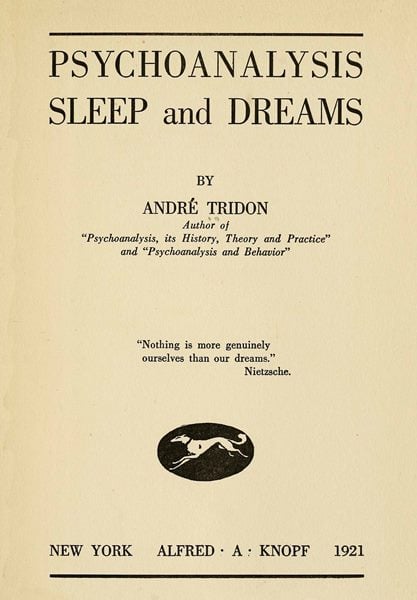How André Tridon’s Psychoanalysis: Sleep and Dreams Aligns with Contemporary Research
When André Tridon published Psychoanalysis: Sleep and Dreams in 1921, he was writing during a fertile period in psychoanalytic theory—just after Sigmund Freud revolutionized how people thought about dream life, sexuality, and the subconscious. In Tridon’s work, we see a spirited application of psychoanalysis to everyday concerns: insomnia, nightmares, the symbolic nature of dreams, and the interplay between hidden wishes and one’s waking life. Despite the century that has elapsed since its publication, Tridon’s ideas, especially his focus on wish-fulfillment, the defensive function of dreams, and the psychology of sleeplessness, resonate in many ways with modern discoveries in clinical psychology, psychophysiology, and neuroscience. Below is an in-depth look at how Tridon’s central themes correlate with—rather than contradict—more current research into sleep, dreams, and mental health.
1. Dreams as a Form of Wish-Fulfillment and Emotional Regulation
Tridon, following Freud’s lead, places front and center the claim that dreams serve a wish-fulfilling function. In his view, dreams are an imaginative gateway that allow repressed desires—sexual, aggressive, or otherwise—to emerge in disguised, symbolic form while we are less guarded in sleep. According to Tridon:
“[T]he psychoanalytic pronouncement that dreams are the fulfillment of wishes meets with so much hostility… The man who has a dream of gross sex or ego gratification dislikes to have others think that the desire for such gross pleasure is a part of his personality.”
Modern Research Parallels
Emotional Processing in REM Sleep
Contemporary sleep researchers such as Rosalind Cartwright, Ernest Hartmann, and others have demonstrated that rapid eye movement (REM) sleep appears to be associated with emotional regulation and processing of salient life events. While many neuroscientists frame this in neurochemical terms—heightened activity in limbic structures, reduced prefrontal inhibition—there is agreement that dreaming reflects underlying emotional preoccupations. Tridon’s notion of a “wish” expands neatly into our modern idea of emotional resolution in REM sleep.Threat Simulation and Adaptive Function
Some contemporary cognitive theories (e.g., the threat-simulation hypothesis by Antti Revonsuo) argue that dreams help us mentally “simulate” threatening scenarios to better respond to them in waking life. This partly dovetails with Tridon’s notion of dreams as an unconscious solution-finding tool—a place to “work out” or “fulfill” the day’s unresolved cravings or worries in the safety of our inner theater.
Thus, although Tridon’s emphasis lies on “wish-fulfillment,” more recent approaches frame dream content as a broader mechanism for emotional problem-solving, memory consolidation, and stress regulation. One can argue that the “wishes” can also be read as pressing emotional needs—painful or pleasurable—that we work through at night.
2. The Protective Function of Dreams and Convenience Dreams
Tridon’s text repeatedly underscores that dreams help us stay asleep by weaving external or internal stimuli into dream content. Instead of rudely awakening us every time something interrupts our physiology—an overfull bladder, a stray noise, or a chilly room—dreams creatively incorporate or “explain away” these disruptions. He calls these “convenience dreams.”
“In every convenience dream which I have analysed, I have found a close connection between the image conjured up by the dream work and the ideas generally occupying the dreamer’s mind in his waking states.”
Modern Research Parallels
Sensory Incorporation
Laboratory research has shown that sleepers frequently integrate external stimuli (a soft noise, a smell, a light) into their dream storylines, preserving sleep continuity. Current models of dreaming (e.g., the AIM model by Hobson and colleagues, focusing on activation-synthesis) and overnight PSG (polysomnographic) studies confirm that the sleeping brain has partial awareness of peripheral stimulation. This aligns with Tridon’s explanation that the mind “explains away” such stimuli in dreams, allowing continued slumber.Insomnia Research
Cognitive-behavioral researchers studying insomnia have found that hypervigilance and worry about external cues can fragment or prevent sleep. In Tridon’s words, if we do not find a convenient dream-based explanation—or if our psyche remains too guarded—arousal can escalate, leading to difficulty maintaining sleep. Thus, Tridon’s 1921 concept that dreaming “protects” us from waking resonates with modern insomnia treatments, which help patients reduce nighttime vigilance and find ways to “accept” bodily or mental sensations.
3. Symbolism and the Use of Metaphor in Dreams
Another hallmark of psychoanalysis is the idea that the unconscious mind expresses itself through symbols. Tridon devotes many pages to illustrating how everyday objects, people, or animals in our dreams can stand in for hidden yearnings, conflicts, or repressed memories.
“Symbolization is a reduction of an object to one essential detail which has struck us as more important than the others.”
Tridon’s catalog of classic symbols—snakes representing sexual desire, houses symbolizing the body, falling dreams reflecting a regression or fear of re-entry into reality—mirrors a long tradition of symbolic interpretation in psychoanalysis.
Modern Research Parallels
Neurocognitive Theories of Dreaming
Researchers like Mark Solms, who integrates Freudian ideas with neuroscientific data, still find that dream narratives are heavily influenced by personal metaphors and emotional salience. Brain imaging has revealed that dream content correlates with highly activated limbic and visual areas, but less so with regions responsible for linear, logical thinking. This diminished executive control may indeed foster a more metaphorical, image-based language akin to Tridon’s “symbolization.”Contemporary Psychodynamic Therapy
In certain therapy practices today—especially Jungian and psychodynamic approaches—therapists continue to work with patients’ personal dream symbols. While not everyone endorses a universal “dictionary” of symbols (the critique often aimed at early psychoanalysis), the idea that repeated images or motifs in dreams reflect underlying emotional or relational themes remains widely accepted. In that sense, Tridon’s approach is still relevant, so long as we adapt it to the individual’s current cultural context and personal experiences.
4. The Function of Sleep: A Flight from Reality
Tridon’s argument that “we sleep in order to dream”—or more precisely, that we take refuge in sleep as an escape from daytime stress, threat, or monotony—is a strikingly modern notion. He details numerous examples of “abnormal sleep states,” such as narcolepsy or extended “sleeping sickness,” which he interprets partly as an extreme flight from an unbearable situation.
“No better way has been devised for probing the unconscious than the honest and scientific study of dreams… Furthermore, dream study and dream study alone, can help us solve a problem which scientists have generally disregarded or considered as solved, the tremendous problem of sleep.”
Modern Research Parallels
Stress, Fear, and Insomnia
Today’s “3P model” of insomnia (predisposing, precipitating, perpetuating factors) aligns with Tridon’s view that intense worry, fear, or dissatisfaction can disturb the normal willingness to drift off to sleep. While modern science also points to physiological hyperarousal, stress hormones, and circadian misalignment, Tridon’s emphasis on “fleeing reality” suggests that, psychologically, if we cannot let go of our defenses and daily burdens, we resist or disrupt our natural sleep processes.Depression and Hypersomnia
It is well-documented that a subset of people with depression experience hypersomnia—sleeping excessively—often as a coping strategy. Tridon’s anecdotal accounts of individuals “too tired to stay awake” after losing an important battle (Napoleon after Aspern) or enduring deep misery echo modern findings: overshadowing despair can lead some to “hide” in sleep. Indeed, a portion of depressed individuals use sleep to escape from sadness or shame. This reflects not only a bodily phenomenon but also an emotional one, consistent with Tridon’s psychoanalytic perspective.
5. Nightmares and Anxiety Dreams
One challenge often leveled at psychoanalysis is how to account for unpleasant dreams. Tridon, following Freud, sees nightmares as repressed desires or anxieties that the dreamer fails to recognize as their own—and therefore experiences as frightening, alien forces.
“He who accepts the fact that his feet are tender and broken glass dangerous, and goes forth, shod in the proper footgear, will probably remain whole, mentally and physically… When we realize that our unconscious is ours and ourselves… we shall know our limitations and our potentialities and be free from many fears.”
Tridon contends that nightmares highlight a conflict: a dream scenario that would fulfill a desire, yet feels frightening precisely because we resist or disown that desire.
Modern Research Parallels
Trauma and Recurrent Nightmares
Contemporary PTSD literature confirms that nightmares often reflect unresolved trauma, whether through direct re-enactment (re-experiencing the event) or symbolic images of threat. While Tridon’s day had little formal research on PTSD, his argument that anxiety dreams reflect powerful wishes or conflicts—and that repeated nightmares signal unresolved mental content—aligns with how modern clinicians treat trauma-related dream disturbances.Neurobiology of Threat
Neuroimaging shows heightened amygdala activation and reduced prefrontal modulation in nightmares, consistent with an emotional overload. Even if we do not always label it “wish-fulfillment,” the underlying principle that nightmares revolve around potent unresolved emotions (fear, helplessness, sometimes aggression or guilt) still echoes Tridon’s psychoanalytic logic.
6. Application to Insomnia and Sleep Disturbances
Perhaps the most remarkable element of Tridon’s text—given its 1921 publication date—is his extensive discussion of insomnia as a fear of letting go. He posits that people who cannot surrender to sleep often do so because they unconsciously sense that, once asleep, repressed desires or painful conflicts will surface unfiltered in their dreams.
“Sleeplessness is due to the fact that, in our fear of incompletely repressed cravings, we do not dare to become… our primitive selves.”
Modern Research Parallels
Hyperarousal Theory
Much of modern insomnia research highlights hyperarousal, where individuals remain in a state of heightened sympathetic tone—either from stress, worry, or other physiological triggers. This is not entirely divorced from Tridon’s observation that “fear of certain unconscious truths” might make the mind reluctant to relax its guard. While we now talk about “somatic tension” and “racing thoughts,” the overlap is clear: a failure to relinquish daytime vigilance.Psychotherapeutic Interventions
Cognitive Behavioral Therapy for Insomnia (CBT-I) uses techniques that help patients face and neutralize nighttime worries; in a more psychodynamic framework, patients are encouraged to explore the deeper conflict or fear behind their sleeplessness. Tridon’s suggestion that accepting “biological facts observable in our unconscious” can alleviate insomnia is not unlike a contemporary approach that helps insomniacs come to terms with stressors and practice letting go, mentally and emotionally, before bedtime.
7. Relevance to Contemporary Psychoanalytic and Integrative Approaches
While mainstream psychology and psychiatry have embraced biological and cognitive-behavioral approaches, psychoanalysis and psychodynamic therapy remain active in clinics and private practice worldwide. Tridon’s text shows that:
- Dreams are a Key to the Unconscious
This idea remains central in many psychodynamic modalities that use dream material as a gateway to deeper self-knowledge. - Symbols and Metaphors
Rather than reading dream symbols as uniform or universal, modern clinicians adapt the exploration of dream images to each individual’s biography, a method that still respects the principle that dream images are condensed or disguised thoughts. - Emphasis on Individual Variation
Tridon himself recognizes that the same physical stimulus (for instance, tickling the face or the need to urinate) can evoke very different dream narratives. This personalized dimension prefigures modern individualized, case-by-case analyses.
Conclusion
Despite a century separating André Tridon’s Psychoanalysis: Sleep and Dreams from our current era, much of what he proposes finds parallels in today’s research—when interpreted through contemporary lenses. His stance that sleep and dream life reveal our repressed wishes and conflicts lines up with current understandings of how the sleeping brain processes emotional and memory-laden material. His insights into insomnia as a refusal to relax one’s guard, or nightmares as expressions of hidden cravings, are echoed (in different terminology) by hyperarousal theories and trauma models of today. Even his concept of “convenience dreams” resonates with modern experiments demonstrating how external stimuli are integrated into the dream narrative to preserve sleep continuity.
Where we must be careful is in overstating a purely psychoanalytic explanation for all dreams or all insomnia. Modern sleep science recognizes that genetics, circadian rhythms, physiological stress responses, and neurochemical processes also play fundamental roles. Yet Tridon’s call “to accept our unconscious as ours and ourselves” foreshadows a more holistic perspective on mental health—one acknowledging that psychosomatic unity is crucial to understanding why we dream, how we sleep, and what stands in the way.
In short, Tridon’s 1921 text remains a thought-provoking classic that “jives” with contemporary lines of research in emotional regulation, dream incorporation, and the psychosomatic roots of insomnia. Where purely Freudian language might feel antiquated, the deeper message—about how psyche and soma co-create our sleep—is supported by a century of subsequent scientific findings. And ultimately, as Tridon repeatedly emphasizes, the nightly plunge into dreams offers not only rest for the body but a necessary respite and playground for the mind—still as relevant in today’s hectic world as it was in the early days of psychoanalysis.


















